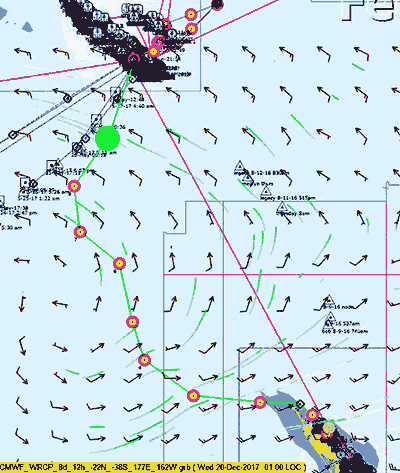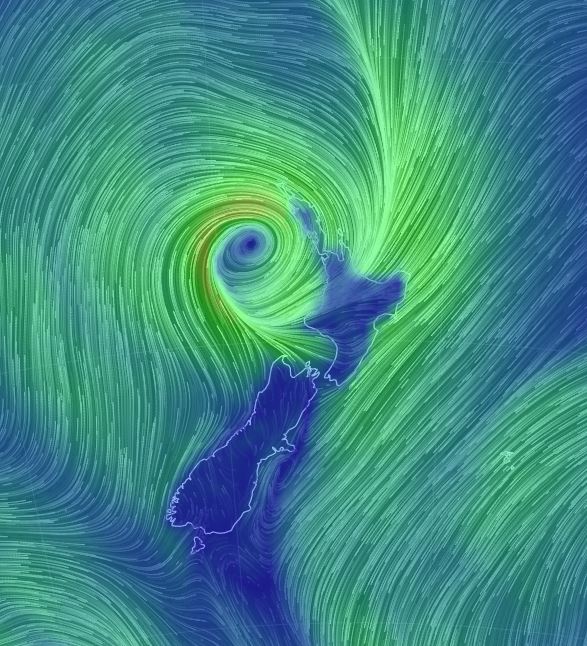January 7, 2018
(A rare current comment from Cyndi)
First, I’d like to comment on our passage from Noumea:
–Once again, we had rather late departure for the passage between the tropics and the “Lands Down Under.”
–Once again, this was because we were waiting for a decent weather window, hoping to have a reasonably comfortable crossing.
–Once again, we managed to enjoy the wait: with no weather window in sight, we got out and did some really, really nice cruise outings in New Caledonia’s lagoon. The weather gods were kind and (with the exception of a couple of days) the air temperatures were comfortably warm and lovely, probably a big part of why we didn’t feel in any hurry to leave (heat drives us out much faster than cold does, and when the temperature is this pleasant it’s hard to feel in a hurry to go).
We did, however, worry about cyclones and after an MJO pulse upped the possibility that a cyclone could develop, we decided if we didn’t get a weather window in the coming week, we’d go to Australia instead of New Zealand. We even procured Australian visas so we’d have the option to go there if need be.
Shortly after, we heard from Bob McDavitt, our weather router: there was a possible window, but it would not be a straight path to New Zealand. Instead it would involve a sort of arc towards Australia then take a sharp left turn towards New Zealand when the time was right, thus turning a 6 or 7 day passage into a 9 or 10 day passage, exchanging comfort for speed. We’re all about comfort, so we decided to go for it.
It didn’t quite go quite as planned; yet the results were the same in the end. The plan was go SW towards Oz, wait for a high pressure zone with very light winds and seas, then enter it and motor east towards New Zealand in light and variable winds. Some weather patterns changed along the way and we thought we’d cut a corner and get to New Zealand earlier. This is where we ran into two misjudgments on our part:
1. First, we assumed we could easily motor into 5-knot average winds and light seas. We usually can in a lagoon or, say, the northern hemisphere, but the southern ocean has such a mixed bag of swells that it can become like a washing machine. Even in very light seas and wind, our speed went down to about two to three knots every time we tried to head east into the breeze.
2. Second, we underestimated the current we’d have against us. It came from the south and the east, almost like it was taunting us, “Neh neh, bet you can’t make it to New Zealand!” In all fairness to us and our weather router, the currents predictions are remarkably unreliable. In the past, we’ve found even the “sure-bet currents” off the coast of Australia are far, far from being a sure thing. In this case we had between 1 and 2 knots of current against us the entire way.
In spite of the surprises, we ended up remarkably close to the original plan Bob McDavitt outlined for us before we left. The path remained mostly the same, but the reasons for the path less positive than planned. Generally we ended up with the true wind on the beam, the apparent wind ahead of the beam, which, for us, falls into the category of “going to weather.” But with low swells and mild seas, we really can’t complain.

In all, there were only a couple of really trying times. The first was after we turned east towards New Zealand. We had 20 knots of wind on the beam, which I know doesn’t sound bad but the accompanying swells were uncomfortable. This lasted a day and a half before mainland New Zealand kindly blocked part of the swell and made life so much better.
The other trial was more mental than physical when we thought we had less fuel than we actually did. The feeling of being low on fuel, having no wind, and having current against us brought up a feeling of vulnerability that’s hard to describe. Everyone is afraid of storms, but in it’s own way, days of limp sails and glassy water without enough fuel to motor out of it can be just as frightening. The worst moment was when we started moving backwards in the strong current. What happened to all our fuel, we wondered? Turns out it was still there: when we poured the rest of our fuel into the tank from jugs we found our fuel gauge was off.
Finally near the end of our passage we got a big break: the wind was supposed to go southeasterly as we turned down the east coast of New Zealand but it stayed southwest. Making that last turn to go down the east coast, I told Rich, “I guess we’re going to make it to New Zealand after all.” It never felt like a given until this point as easier-to-get-to Australia always lurked. Yes, the wind was still ahead of the beam, but with the seas blocked, motor-sailing down the coast was easy peasy. By the time the wind did turn southeast, we were close enough to the Bay of Islands that it didn’t matter.
It’s hard to describe the happiness we felt as we motored through the Bay of Islands towards the quarantine dock. All along, we’d told ourselves that it would be OK if we ended up in Australia, but being here now made that scenario unimaginable! It’s not that we don’t want to go back to Australia (we very much do), but right now, this is where we want to be, and making it here felt wonderful.
The next hurdle was getting cleared into the country and settling into a slip at the marina. The question of how long to stay in Opua was answered for us quickly: the marina only had a slip for a few days. We could have moved to a bigger and more expensive slip after that, but we decided to keep going to our destination for the season: Tauranga. But there was an issue: a low was bearing down on New Zealand and we’d have to race it in if we went for Tauranga. It looked too close for comfort.

In spite of the coming weather system, we decided to vacate our slip and make our way south. Realizing it would be too close for comfort to go for Tauranga, we decided that a harbor much closer called Whangaruru looked like a good bet. We found a spot with protection from the northeast, the northwest and the west.
It turned out to be an excellent choice: we had strong winds for about 2 days, but in a 24 hour period the winds went from northeast to northwest and gusted up to 60 knots. During this time we felt safe and secure, although the noise of strong winds kept us up for part of a night. Still, we felt like it was a feather in our cap to ride out one of these “monster” storms at anchor rather than at a marina, a first for us. Below, some video from the beginnings of the storm.
The worst of it came in the middle of the night; so we have no footage of that.
I would like to take a moment here to give a shout out to our Rockna anchor. It held us beautifully through this storm; we didn’t drag a bit. Plus trusting it as we do; we didn’t feel the need to stay up all night to keep an anchor watch. Yes, having an anchor alarm app on our phone helps a lot with our peace of mind, but having an anchor we trust at times like this is priceless.
Now, after a couple of days in Whangaruru, we are making our way to Tauranga, taking a longer route than planned and making some stops along the way. We had planned to go straight from Opua to Tauranga on an overnight passage, no stops on the way because of the dreaded and very crowded Silly Season (holiday season). But the Monster Storm seems to have sent, and kept, many boaters at home; thus we’ve had room to anchor in our chosen spots so far and hope this continues.
If all goes as planned, we’ll have a day in beautiful Waiheke Island before a stop at Great Mercury Island. We’ll then head south and though the pass around Mount Manganui when the tide is right. When the tide is slack, we can go “home” to our beloved Tauranga Bridge Marina.
After we arrive we’ll be taking a break for awhile, but many blog posts, some of them written on the passage, are ready to be posted.–Cyndi
Note: There are some pictures from our passage here, and Rich’s post about the storm here..





